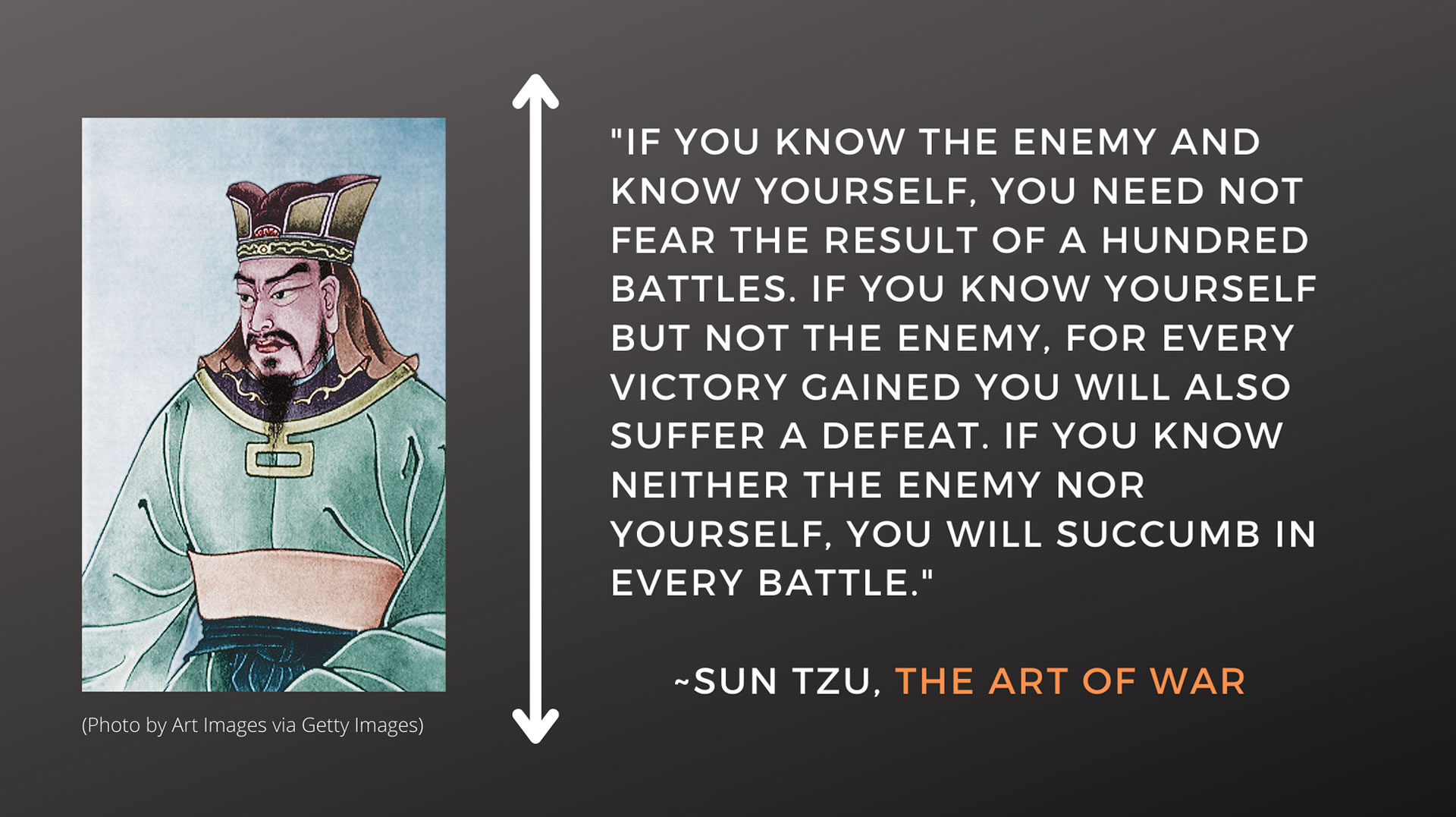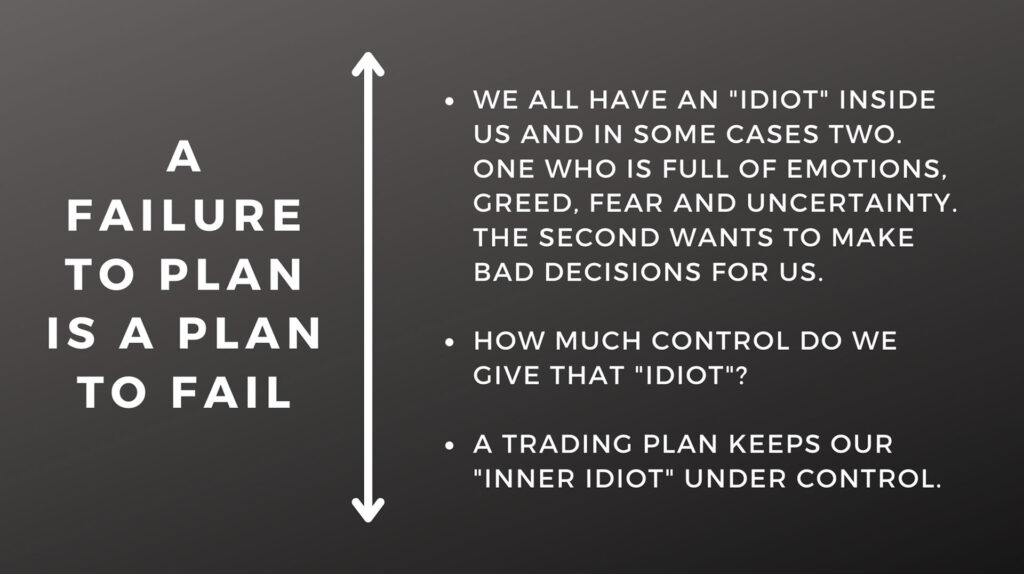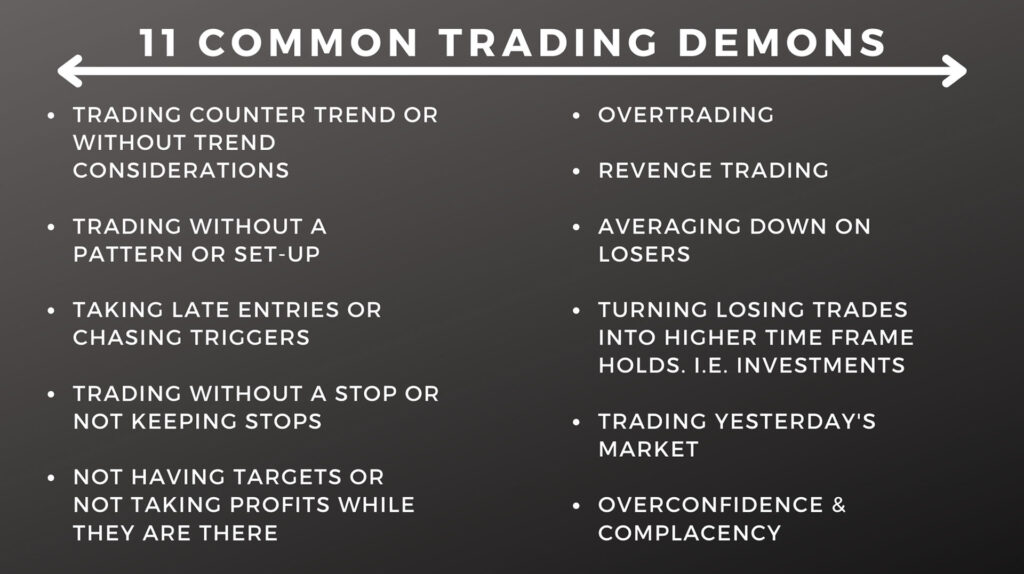Every trader that starts out on Wall Street is told to get a copy of the classic Art of War written by Sun Tzu. It is a book on strategy that translates well to trading, not just warfare. In trading, there are many pitfalls and enemies, both externally (such as other traders and large institutions) and internally (inside your own head such as your fears, uncertainty, and greed). We call these internal enemies your “inner idiot” which we will discuss in a bit.
Every trader goes into the market expecting that they are going to be the one to make money and profit from the markets. Of course, not everybody profits. In fact, most beginning traders lose, but the key question is how do we get ourselves to have a winning mindset? We need to be the trader that goes into the market consistently and pulls our profits from others who are also expecting to win.
We will be exploring our internal enemies over the next two blog posts this month. We will explore eleven trading demons and the ways to overcome them. We will then discuss building trading muscles and reflexes that will serve you well in all trading situations that you may face.
Let’s consider the “inner idiot”. We, as human beings, are full of wild emotions. We have attachments and expectations relating to our money. We each have a personal longing to be right and have different reactions to being wrong. All of these reactions and relationships to different things (our emotional intelligence) make up our trading psychology.
It is for this reason that we need to create a planned approach to trading created from our rational mind at a time when our emotions are not pulling on us. The best time to create a trading plan is when the markets are not open and we aren’t in any active trades. This way, our mind is clear and we are only thinking rationally about the problem at hand. This planned approach is how we are going to be among the traders who profit.
A trading plan is how we are going to create rules and disciplines that will manage the emotions of our “inner idiot”. This is how we will keep our “inner idiot” under control once the market is open.
Trading Demons
A demon is something that hides in the shadows waiting to come out in a moment of weakness, to tempt an individual to do something that they should not be doing. In trading, our trading demons do the same by lurking in the dark corners of our mind waiting to find us in a situation that we have not planned for. They look to tempt us into making a bad trading decision. A bad trading decision is one that has low odds of working out in our favor or has high odds of us taking a greater-than-calculated risk.
The first step to avoiding these trading demons is to know and recognize the most common of them. Below, we will be discussing the top 11 most frequent trading demons.
- Trading counter trend or without trend considerations:
Counter trend trading, or trading without trend considerations, is a function of our greed and our personal need to be right. Even though every indication is saying that the market is currently going up, we want to pick a spot that the market will reverse. We want to make a huge profit by being right and starting the new move against the current direction. Trading without trying to consider the trend is being negligent to the fact that markets have a great tendency to trend in a specific direction until that direction is exhausted and ready to reverse. That happens far less frequently than we think.
- Trading without a pattern or set-up:
Trading without a pattern or a set-up is like being sloppy. Patterns are low risk gateways into trends. They allow us to join a trend without having to sit through lots of pain, so picking our spots by using patterns helps us stay focused in a positive way.
- Taking late entries or chasing triggers:
Often as traders, we are watching the markets rise or fall moments after we decide to take a trade. Although, we may not yet have gotten in and we are watching the trade go in the direction that we thought it would go, but we have yet to take our position. As traders, we need to be able to know approximately how big the expected move was supposed to be. That way we can judge whether or not it is worth it, from a risk reward perspective. We need to ask ourselves “do I get in now? Or did I miss part of the move?” Also what “if we get in now, will it reverse as we already missed the move?”
- Trading without a stop or not keeping stops:
Every trade needs to have an “Uncle” or “Stop” point. This is the point where the trade is clearly not working and we need to get out. If we do not have a stop in mind before we take the trade, then we have fallen into this trading pitfall. Also, if we have ignored a stop, we might as well have not had any stop at all. In trading, we need to think about stops as our emergency protection plan as they keep us in business and protect our bankroll (our trading capital). No one trade should ever threaten our entire trading business. Stops may be frustrating at times, as we will often be stopped out of trades that would’ve worked, but overall we need to accept that stops are there to protect us from losses that would exceed our acceptable tolerance levels. Know your stop point before you take every single trade.
- Not having targets or not taking profits while they are there:
You should have a profit target in mind before you take any trade. If you do not know your stop point and your first profit target, you cannot calculate your risk/reward ratio. Have a target limit order in place just moments after you take every trade. If you are deciding where to take profit while in the trade, you are most likely basing your trading decisions off of subjective emotional feel rather than objective chart data.
- Overtrading:
As traders, we don’t have to work too much. One trade can make a month’s worth of profits if managed correctly. That doesn’t mean we feel satisfied with sitting on the beach all month while we let our trades correctly play out. Sometimes, we feel the need to work and earn our pay which can result in overtrading. This can lead to higher commission costs without extra discernible gain. Proper trading is proper thinking and sometimes we don’t need to trade a lot to make a lot of profits.
- Revenge trading:
Most of us do not like to lose which means when we do lose, we want to make our money back. That feeling of loss and our need to make the money back from a specific stock or position can lead to revenge trading. Stocks or financial instruments don’t have emotions; it’s not personal.
- Averaging down on losers:
Our human need to win can manifest itself into a trading demon by not keeping stops and then averaging down on the loser as not to give up. This is a compounding error and can be avoided by first having stops and then by keeping them. Finally, you just do not add to losers when you’re down. It is only okay for you to add to a position before your stop point is hit (called averaging down). This should only occur up to a stop point and should also be a planned activity, not something that is done from an emotional or irrational subjective standpoint.
- Turning losing trades into higher time frame holds, i.e., investments:
We may be tempted to turn losing trades into higher time frame holds by rationalizing the loser into a long-term investment. It’s important to keep your mindset correct. If you took a trade as a trade it should stay as such, while investments should stay as investments. Before you take any trade, you need to know your stock and your target as well as what you expect out of that trade. It should fit into your trading plan and stick to your original set of expectations.
- Trading yesterday’s market:
Sometimes we cannot trade every day and we miss a day when something we may have expected happens. We should never go into the market with a set of expectations that are not relevant to the current market situation. Always read the markets from an objective standpoint and avoid projecting our past expectations onto current market situations.
- Overconfidence and Complacency:
Long periods of success lead to overconfidence and complacency. Markets are designed in such a way that some types of behavior are rewarded until they are not. Be sure to stay objective and on guard. For instance, buying the pull back in an uptrend is the right thing to do for as long as that uptrend lasts. As soon as that uptrend shows signs of faltering, a trader must be more careful and adjust his/her behavior accordingly. Otherwise, that trader will fall into the pitfall of overconfidence and complacency. Gains can quickly be erased if we continue to use the wrong technique in the wrong trend consideration. Recently, we have heard a lot about YOLO (You Only Live Once) trading. This attitude can be dangerous to long-term trading success.
Proper Trading is Proper Thinking
We cannot control the markets, but we can control our interaction with the markets. This is summed up in the phrase “Proper Trading is Proper Thinking”. All of our interactions with the markets should be premeditated. Traders should have a plan and when the market makes a move our trading reflexes should kick in. We should execute the counter move as laid out in our trading plan. Be on the lookout for our next blog where we will lay out how your trading plan helps to defuse all of your trading demons.Trade well!
Written by Michael DiGioia, Director of Institutional Sales
Mike is available for One-on-One Coaching. Learn More







